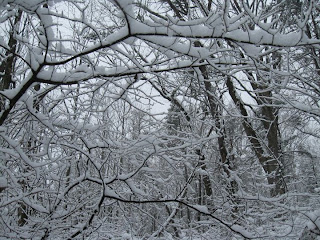Snow
It is winter in the Delaware Valley and, at the time I am writing this post, snow is on the ground and clinging beautifully to the trees. Most of us have lived through this kind of weather our entire lives, but how many actually know why it snows or if every snowflake is really unique?
To find out why it snows, I went to the experts at the National Snow and Ice Data Center. According to their website, snow is
“precipitation in the form of ice crystals. It originates in clouds when
temperatures are below the freezing point (0 degrees Celsius, or 32 degrees
Fahrenheit), when water vapor in the atmosphere condenses directly into ice
without going through the liquid stage. Once an ice crystal has formed, it
absorbs and freezes additional water vapor from the surrounding air, growing
into a snow crystal or snow pellet, which then falls to Earth.” Sleet, a type of precipitation very familiar
to our region, is a form of snow but hail is not. To find out even more about snow, visit their
Snow Science page.
Whether or not no two snowflakes are alike is both an
oft-cited bit of popular culture and a more-complicated-than-you-might-think
science question. Chairman of the
CalTech Physics Department, Kenneth G. Libbrecht, explains all the permutations
on his SnowCrystals site. The simple answer is no although,
as Dr. Libbrecht explains, it all depends on what you think of as “alike” and
what you think of as a “snowflake.”
If it is too cold to go outside, here are some indoor ways
to enjoy snow, snowflakes and winter in general:
·
Learn how to crochet snowflakes by reading Caitlin
Sainio’s “100 Snowflakes to Crochet: Make Your Own Snowdrift – To Give or
Keep.”
·
Decorate your windows with spray snow – eHow
Crafts gives directions. Try using doilies for a delicate, snowflake
look.
·
Create a wintercenterpiece for your table. Martha Stewart shows us
how to make a variety of perfect for winter.
·
Cook some comfort food. For a healthy version of your favorites,
check out America’s Test Kitchen’s Comfort Food Makeovers: All Your Favorites Made Lighter. Search “comfort food” in
the library’s catalog for a long list of other great titles.
·
Have your own movie marathon for chilly days and
nights. Take a look at the American Film
Institute’s “100 Years” lists for ideas
and then visit the library to check out the movies!
Of course, one of the best ways to enjoy the snow and
winter is watching it outside the windows of your local library branch as you
relax in a comfortable chair with a book.
-Andrea
at the Hopewell Branch
Photo courtesy of Jimmie Ocean

Lovely picture!
ReplyDeletedid you (all) know that snow is actually colorless? what little sunlight is absorbed by snow is absorbed uniformly over the wavelengths of visible light thus giving snow its white appearance. and the fear of snow is known as chionophobia. the average snowflake falls at the speed of 3.1 miles an hour!
ReplyDelete